Ground Covers Imagine a garden that’s both beautiful and easy to care for. It’s filled with stunning succulent ground cover plants that show off your style. With so many options, you can make a garden that’s truly yours. Succulent ground covers add elegance and sophistication to any outdoor space.
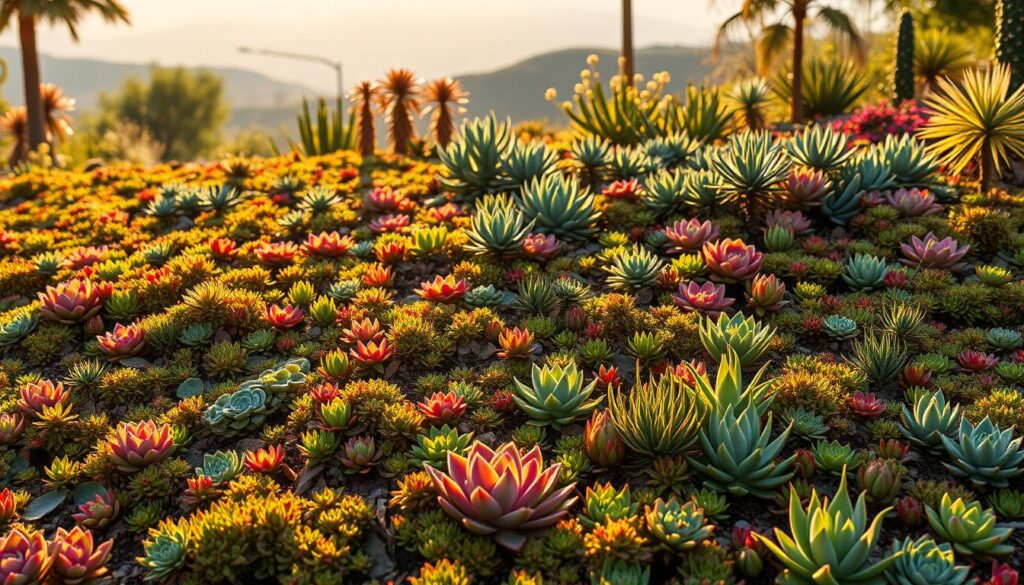
Succulent ground covers are key to a stunning garden design. They bring texture, color, and depth to your landscape. Plus, they’re low-maintenance, making them perfect for those with busy lives.
Table of Contents
Key Takeaways
- You can create a unique and stunning landscape with succulent ground cover plants
- There are many types of succulent ground covers for your garden to choose from
- Succulent ground cover plants are low-maintenance and easy to care for
- They can add texture, color, and depth to your landscape
- Succulent ground covers are perfect for busy homeowners
- You can use succulent ground cover plants to create a beautiful and cohesive look in your garden
Understanding the Appeal of Succulent Ground Covers
Thinking about adding succulent ground covers to your garden? They’re a hit for a reason. These plants are great because they don’t need much water and can grow in many conditions. They also make your garden look amazing.
Succulents help prevent soil erosion, which is key in wet or poor soil areas. They also help clean the air, perfect for city gardens. This makes them a smart choice for many gardeners.
What Makes Succulents Perfect for Ground Cover
Succulents spread fast and fill in empty spots, making them ideal for ground cover. They’re also easy on the wallet, which is a big plus. Some top picks include sedum, sempervivum, and delosperma.
Benefits for Your Landscape Design
Succulent ground covers bring elegance and simplicity to your garden. They’re also a smart choice for tough soil. With their wide range of shapes, sizes, and colors, they fit any design.
Environmental Impact and Sustainability
Succulents are not just pretty; they’re also eco-friendly. They need little water, which is great for places with water limits. Plus, they’re easy to grow and don’t harm the environment.
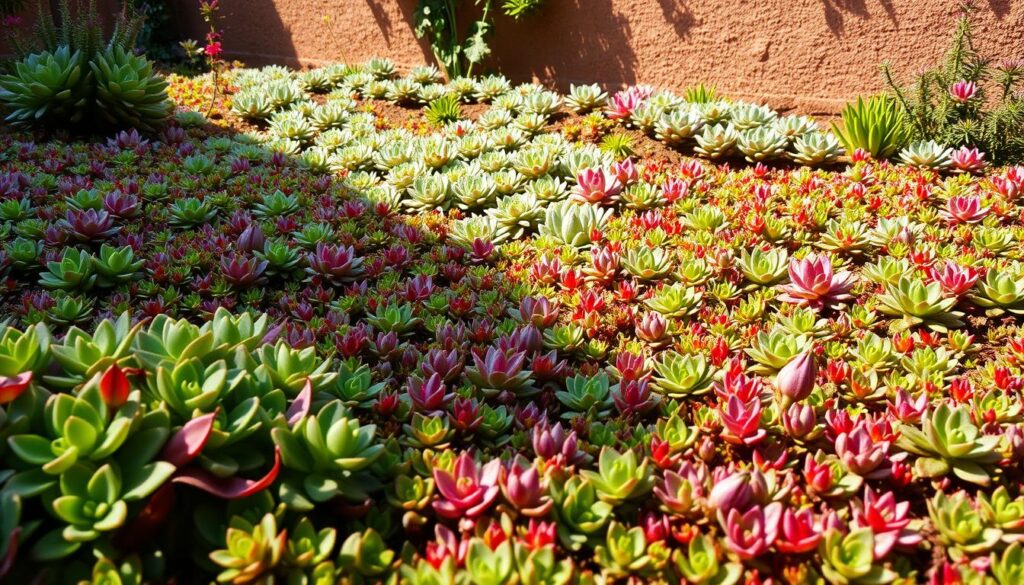
Choosing succulent ground covers means a beautiful, easy-to-care-for garden. They help with soil erosion, air quality, and add beauty. Succulents are a top pick for anyone wanting a low-maintenance garden that’s also stylish.
Popular Types of Succulent Ground Covers for Your Garden
Succulents are great for sunny spots because they don’t need much water. They thrive in dry soil, making them ideal for areas with little rain. Some top picks include sedum, sempervivum, and delosperma.
These plants are not only easy to care for but also add beauty to your garden. They come in many shapes, sizes, and colors. For instance, sedum spreads out like a mat, while sempervivum makes new plants by producing offsets.
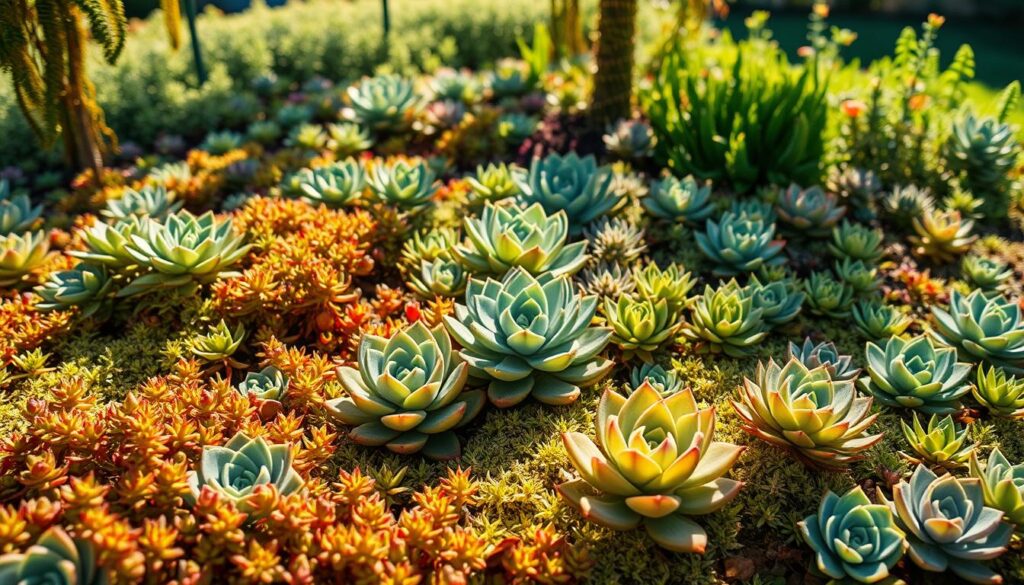
- They are drought-tolerant and can survive with minimal watering
- They are low-maintenance and do not require frequent pruning or fertilization
- They can help to suppress weeds and prevent soil erosion
Choosing the right succulent ground cover can make your garden beautiful and easy to care for. Whether you need something for sunny areas or dry soil, succulents are a great choice.
| Type of Succulent | Description | Benefits |
|---|---|---|
| Sedum | Forms a dense mat of foliage | Drought-tolerant, low-maintenance |
| Sempervivum | Produces offsets that can be used to propagate new plants | Low-maintenance, can help to suppress weeds |
| Delosperma | Produces colorful flowers in the summer | Attracts pollinators, adds color to the garden |
Sedum: The Ultimate Hardy Ground Cover Option
Sedum is a top pick for hardy ground covers for landscaping. It grows well in many conditions, especially in partial shade. It’s also great for evergreen ground covers for shade because it stays colorful even in low light.
There are many types of sedum, each with its own look. Some favorites include:
- Sedum Acre (Golden Carpet): a low-growing, spreading sedum with golden-yellow flowers
- Sedum Album (White Stonecrop): a compact, white-flowering sedum that is perfect for rock gardens
- Dragon’s Blood Sedum: a fast-spreading sedum with deep red flowers
These hardy ground covers for landscaping are not only pretty but also easy to care for. They do well in poor soil and where many people walk. They add color and texture to your garden.
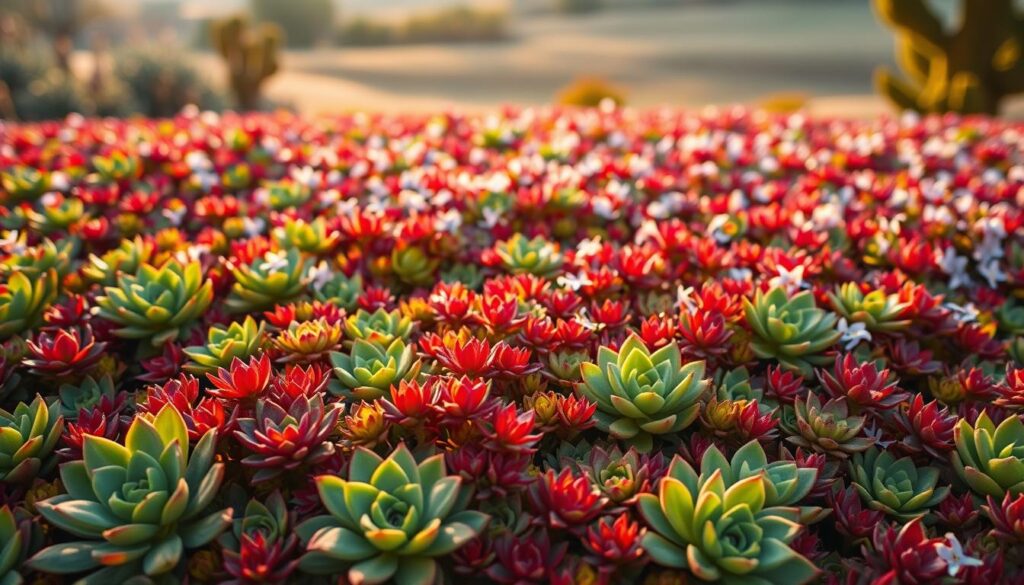
Choosing sedum for your evergreen ground covers for shade makes your garden beautiful and easy to maintain. Sedum thrives in different conditions, making it ideal for adding color and texture to your outdoor space.
| Type of Sedum | Characteristics |
|---|---|
| Sedum Acre | Low-growing, spreading, golden-yellow flowers |
| Sedum Album | Compact, white-flowering, perfect for rock gardens |
| Dragon’s Blood Sedum | Fast-spreading, deep red flowers |
Choosing the Right Location for Your Succulent Ground Cover
When picking a spot for your succulent ground cover, think about the soil, sunlight, and drainage. Ground cover plants for rocky soil are great for areas with bad soil. They do well where other plants might not. Sedum and sempervivum are good for rocky spots and stop soil from washing away.
Make sure your succulent ground cover gets the right sunlight. Most need full sun to partial shade. Also, pick a spot that drains well, as succulents don’t like wet feet.
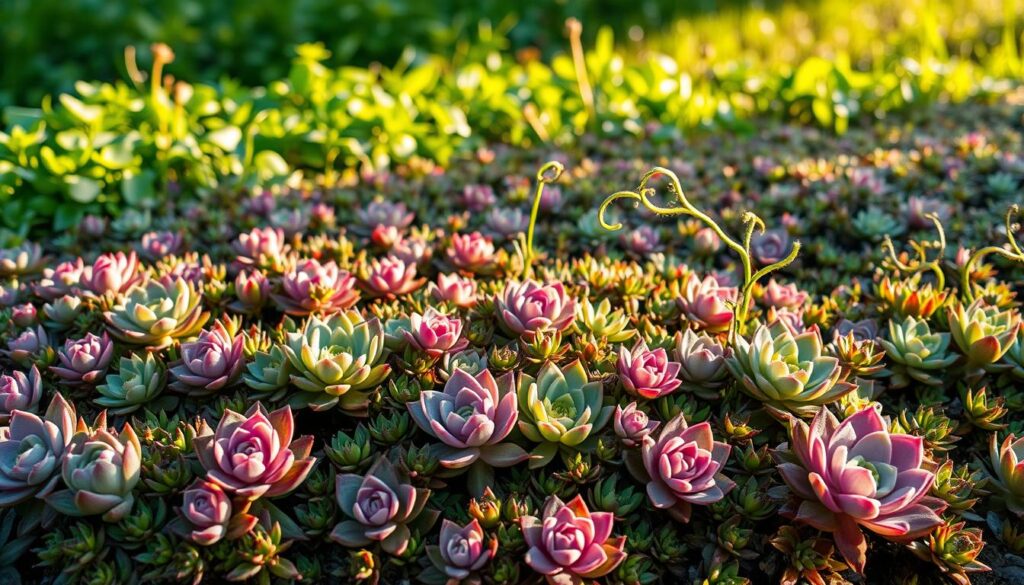
Using ground cover plants for rocky soil has many benefits. They keep weeds down, stop soil erosion, and make your garden look nice and easy to care for. When picking types of succulent ground covers for your garden, think about your area’s needs. Choose plants that fit well, and you’ll have a beautiful succulent ground cover.
- Check the soil type and drainage in the area
- Find a spot with the right sunlight
- Pick succulent ground covers that match your area’s needs
By following these tips, you can make a stunning succulent ground cover. Choose ground cover plants for rocky soil and types of succulent ground covers for your garden that fit your spot. Don’t be afraid to try different plants to find the perfect look for your garden.
Ice Plant Varieties for Stunning Color Display
Ice plant varieties are a hit for their bright colors and easy care. They’re great for adding color to your garden without much work.
These plants come in purple, red, and yellow. Each has its own look and benefits, fitting different gardens and climates.
Purple Ice Plant
The purple ice plant blooms with purple flowers in summer. It’s elegant and drought-tolerant, making it easy to care for.
Red Apple Ice Plant
The red apple ice plant has bright red flowers and spreads well. It’s perfect for big areas and needs little care, great for busy gardeners.
Yellow Ice Plant
The yellow ice plant blooms with bright yellow flowers and grows compactly. It’s ideal for small gardens or pots, adding color and resisting pests.
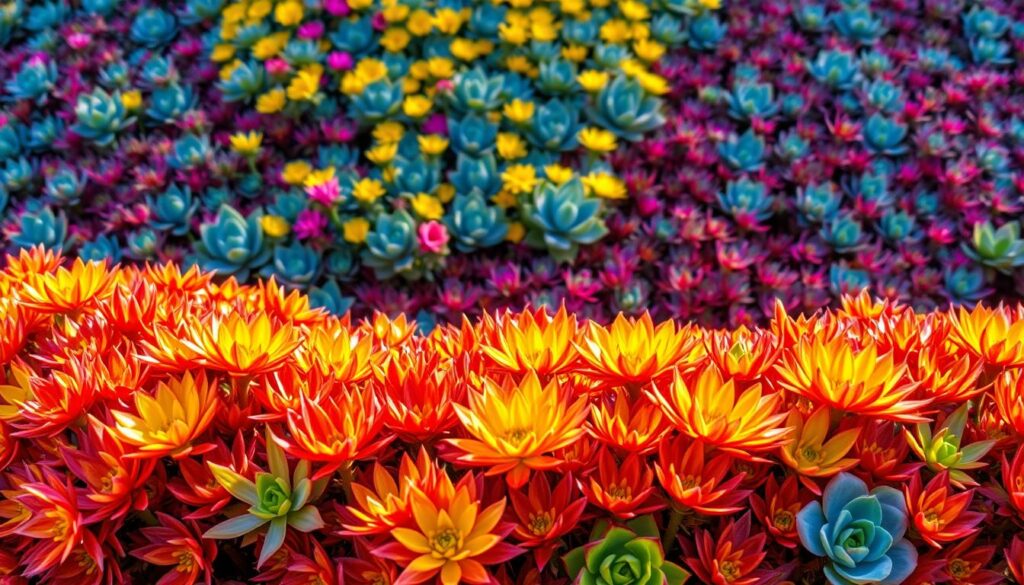
Choosing the right ice plant variety can bring stunning color and low maintenance to your garden. Whether you like purple, red, or yellow, there’s an ice plant for every garden.
Soil Requirements and Preparation Tips
Soil preparation is key for growing drought tolerant ground covers. You need to make sure your plants have the best chance to thrive. The soil should drain well to avoid waterlogging.
To start, test your soil’s pH level. Most succulent ground covers do well in slightly acidic to neutral soil, with a pH of 6.0 to 7.0. You can buy a soil testing kit or get advice from a local nursery.
Here are some tips for preparing your soil for drought tolerant ground covers:
- Remove any debris or weeds from the area
- Loosen the soil to a depth of 8-10 inches
- Mix in organic matter such as compost or well-rotted manure
- Level the soil to create an even surface
By following these steps, you can make a great soil bed for your best ground covers for sunny areas. Make sure to pick a spot that gets full sun to partial shade, based on your plants’ needs. With the right soil and care, your succulent ground covers will flourish and add beauty to your garden.
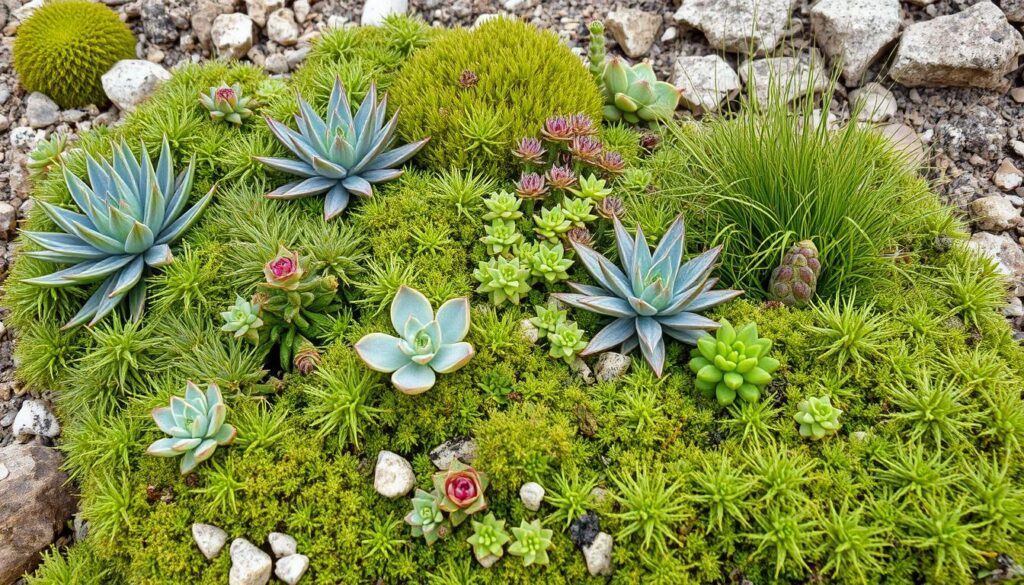
For a thriving garden, consider the following table for soil requirements:
| Soil Type | pH Level | Drainage |
|---|---|---|
| Sandy | 6.0-7.0 | Well-draining |
| Clay | 6.0-7.0 | Improve drainage with organic matter |
| Loam | 6.0-7.0 | Well-draining |
Sempervivum: Perfect for Rocky Areas
Sempervivum is a great choice for ground cover in dry soil. It can grow well in poor soil and rocky areas. This makes it perfect for landscaping.
It adds beauty and texture to your garden. You can use Sempervivum as a hardy ground cover.
Some popular types of Sempervivum include:
- Cobweb Houseleek: known for its unique, cobweb-like appearance
- Red Beauty: features stunning red flowers and foliage
- Green Wheel: boasts beautiful green leaves with a distinctive wheel-like shape
These plants are great for areas with poor soil. They are also easy to care for. They can grow well in rocky areas, making them ideal for landscaping.
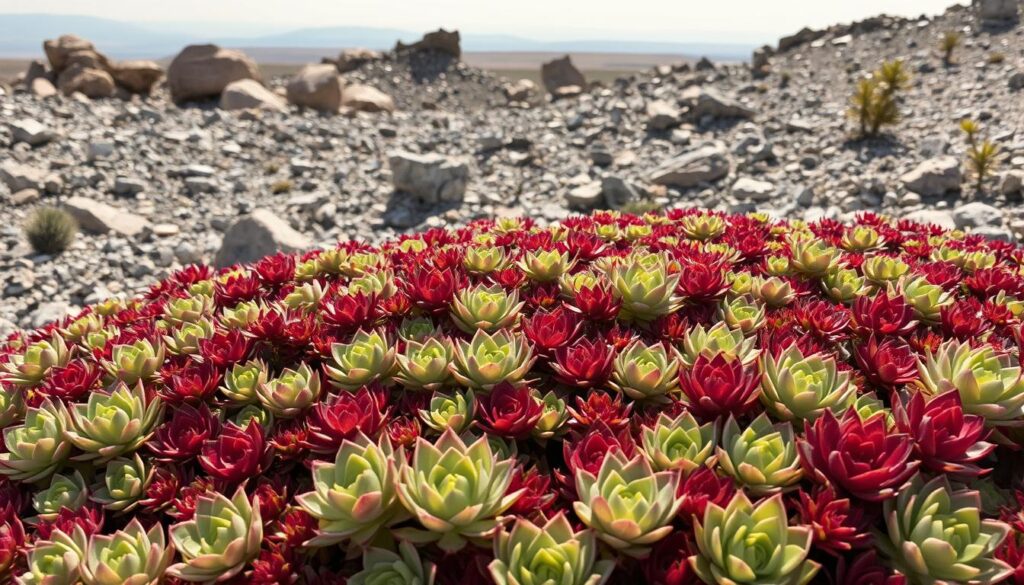
Choosing Sempervivum as your ground cover can make your garden beautiful and thriving. It’s hardy and can grow well in poor soil. Sempervivum is a great choice for ground cover in dry soil and landscaping.
| Type of Sempervivum | Description |
|---|---|
| Cobweb Houseleek | Unique, cobweb-like appearance |
| Red Beauty | Stunning red flowers and foliage |
| Green Wheel | Beautiful green leaves with a distinctive wheel-like shape |
Watering and Maintenance Guidelines
When caring for your succulent ground covers, it’s key to know their specific needs. For evergreen ground covers for shade, they need less water since they grow well in low light. On the other hand, ground cover plants for rocky soil might need more water because rocky soil doesn’t hold water well.
To keep your succulent ground covers healthy, give them the right amount of water and care. Here are some helpful tips:
- Water your succulents in the growing season (spring and summer) when the soil is dry.
- Water less during the dormant season (fall and winter) to avoid root rot.
- Fertilize your succulents in the growing season with a balanced, water-soluble fertilizer.
By following these tips, you can enjoy your succulent ground covers while avoiding common problems. Keep an eye on your plants and adjust your care as needed to help them thrive.
With the right care, your succulent ground covers can bring beauty and joy for years. Whether you’re using evergreen ground covers for shade or ground cover plants for rocky soil, success comes from understanding your plants’ needs and providing the best conditions for them.
| Season | Watering Frequency | Fertilization |
|---|---|---|
| Spring and Summer | Every 7-10 days | Monthly |
| Fall and Winter | Every 4-6 weeks | None |
Creating Stunning Succulent Ground Cover Combinations
Choosing the right succulent ground covers for your garden can be tough. There are so many options, it’s key to think about texture, color, and growth habits. Start by picking a few plants that look good together in terms of texture and color.
For instance, mix soft, delicate succulents with bold, architectural ones for a striking contrast. Plants like Sedum, Ice Plant, and Sempervivum work well together. They add a unique mix of colors and textures that make your garden pop.
- Choose succulent ground cover plants with similar growing conditions to ensure they thrive together.
- Consider the mature size of each plant to avoid overcrowding.
- Experiment with different textures and colors to create a visually appealing combination.
By following these tips and picking the right succulent ground covers, you can make a stunning combination. This will take your garden to the next level, making it more beautiful and charming.
Propagation Methods for Expanding Your Coverage
Want to spread your succulent ground covers across more of your garden? Propagation is a smart way to do this. Succulents are great for this because they’re easy to care for and can grow well in many places.
Succulents are perfect for areas with little rain or where water is scarce. You can use division, leaf propagation, or time your propagation with your plants’ natural cycles.
Division Techniques
Division is a simple way to grow more succulents. Dig up the plant, separate the roots, and replant the sections. Do this in spring or fall when the plant isn’t growing much.
Leaf Propagation
Leaf propagation is another popular method. Take a healthy leaf, let it dry for a few days, and then plant it in soil. With care, it will grow into a new plant.
Timing Your Propagation
When you propagate is key to success. Spring or summer is best because plants are growing. This helps new plants get established before winter.
Using these methods, you can grow more low maintenance, drought tolerant ground covers. Enjoy the benefits in your garden.
| Propagation Method | Best Time | Success Rate |
|---|---|---|
| Division | Spring or Fall | High |
| Leaf Propagation | Spring or Summer | Medium |
| Timing Your Propagation | Spring or Summer | High |
Regional Considerations for American Gardens
When picking the right succulent ground cover, think about your garden’s climate, soil, and sunlight. Best ground covers for sunny areas do well in hot places with lots of sun. For areas with little rain and dry soil, ground cover plants for dry soil are perfect.
In dry soil areas, pick succulents that don’t need much water. Sedum, Sempervivum, and Delosperma are great choices. They can handle full sun to partial shade with little watering.
Here are some tips for choosing the right succulent ground cover for your American garden:
- Consider the climate and soil type in your region
- Choose plants that are drought-tolerant and can thrive in sunny areas
- Plant succulent ground covers in well-draining soil to prevent root rot
| Region | Best Ground Covers | Soil Requirements |
|---|---|---|
| Southwest | Sedum, Sempervivum | Well-draining soil, full sun |
| Northeast | Delosperma, Phlox | Moist soil, partial shade |
By thinking about your region and picking the right succulent ground cover, you can make a stunning garden in your American garden.
Conclusion: Growing Success with Your Succulent Ground Cover Garden
Starting your succulent ground cover garden is exciting. These plants bring beauty, resilience, and simplicity to your space. Whether you pick ground covers for landscaping or evergreen ground covers for shade, you can create a stunning oasis. This article has given you the tools to make your outdoor areas beautiful and low-maintenance.
To grow great succulent ground covers, know their needs and choose the right ones for your area. Follow the advice in this article to make your garden vibrant and sustainable. Your neighbors will be jealous, and you’ll enjoy the beauty every day.
Don’t wait to start with succulent ground covers. Let your creativity shine. Enjoy the journey of growing these amazing plants. Your garden will change in a way that will impress everyone who sees it.
FAQ
What are the benefits of using succulent ground covers in my garden?
Succulent ground covers are great for gardens. They need little care, can handle drought, and stop soil erosion. They also make the air cleaner and add beauty to your garden.
What are some popular types of succulent ground covers I can use?
Popular succulent ground covers include sedum, ice plant, and sempervivum. Each has its own benefits and needs. Think about sunlight, soil, and growing conditions when picking.
How do I prepare my soil for planting succulent ground covers?
Succulent ground covers are easy to care for. Make sure your soil drains well and has the right pH. You might need to add sand or gravel for drainage and test the pH.
How do I care for my succulent ground covers throughout the year?
Caring for succulent ground covers means watching for seasonal needs. Water them right and protect them in winter. Also, watch for pests or disease and fix them fast.
Can I create combinations of different succulent ground covers in my garden?
Yes, you can mix different succulent ground covers for a stunning look. Pick plants based on texture, color, and growth to make a beautiful design.
How can I propagate my succulent ground covers to expand my coverage?
You can propagate succulent ground covers in several ways. Try division, leaf propagation, or timing your propagation for the best season. Each method has its own advantages and challenges.
Are there any regional considerations I should keep in mind when choosing succulent ground covers for my American garden?
Yes, consider your region’s climate, soil, and sunlight when picking succulent ground covers. Some plants do better in certain areas than others. Do your research to find the best fit for your garden.


1 thought on “Ground Covers: Enhance Your Landscape Effortlessly”